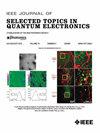Cryogenic High-Speed Vertical-Cavity Surface-Emitting Lasers for Quantum Computing: A Review
IF 5.1
2区 工程技术
Q1 ENGINEERING, ELECTRICAL & ELECTRONIC
IEEE Journal of Selected Topics in Quantum Electronics
Pub Date : 2025-04-08
DOI:10.1109/JSTQE.2025.3558915
引用次数: 0
Abstract
Cryogenic computing such as superconducting computing and quantum computing is a promising alternative to handle the bottlenecks of computing power and power efficiency in classical high-performance computing systems. The high-speed energy-efficient data transfer between cryogenic temperature and room temperature for the superconducting quantum computing is a critical issue. The current electrical interconnect is difficult to meet the stringent requirements in the future quantum computing application with millions of qubits. The optical interconnect based on the fiber is a promising solution because the optical fiber data link has a higher modulation bandwidth, ultralow signal loss, and lower heat load. The cryogenic vertical-cavity surface-emitting lasers (VCSELs) with high modulation speed and low power consumption are the potential sources for the cryogenic optical interconnect. This paper reviews the progresses on cryogenic VCSELs, including the properties of semiconductors at cryogenic temperature, structure optimization, and static and dynamic performance.用于量子计算的低温高速垂直腔面发射激光器:综述
低温计算,如超导计算和量子计算,是解决经典高性能计算系统中计算能力和功率效率瓶颈的一个有前途的替代方案。低温和室温之间的高速高效数据传输是超导量子计算的关键问题。目前的电气互连难以满足未来数百万量子比特的量子计算应用的严格要求。光纤数据链路具有较高的调制带宽、超低的信号损耗和较低的热负荷等优点,是一种很有前途的解决方案。具有高调制速度和低功耗的低温垂直腔面发射激光器(VCSELs)是低温光互连的潜在光源。本文综述了低温vcsel的研究进展,包括半导体在低温下的性能、结构优化、静态和动态性能。
本文章由计算机程序翻译,如有差异,请以英文原文为准。
求助全文
约1分钟内获得全文
求助全文
来源期刊

IEEE Journal of Selected Topics in Quantum Electronics
工程技术-工程:电子与电气
CiteScore
10.60
自引率
2.00%
发文量
212
审稿时长
3 months
期刊介绍:
Papers published in the IEEE Journal of Selected Topics in Quantum Electronics fall within the broad field of science and technology of quantum electronics of a device, subsystem, or system-oriented nature. Each issue is devoted to a specific topic within this broad spectrum. Announcements of the topical areas planned for future issues, along with deadlines for receipt of manuscripts, are published in this Journal and in the IEEE Journal of Quantum Electronics. Generally, the scope of manuscripts appropriate to this Journal is the same as that for the IEEE Journal of Quantum Electronics. Manuscripts are published that report original theoretical and/or experimental research results that advance the scientific and technological base of quantum electronics devices, systems, or applications. The Journal is dedicated toward publishing research results that advance the state of the art or add to the understanding of the generation, amplification, modulation, detection, waveguiding, or propagation characteristics of coherent electromagnetic radiation having sub-millimeter and shorter wavelengths. In order to be suitable for publication in this Journal, the content of manuscripts concerned with subject-related research must have a potential impact on advancing the technological base of quantum electronic devices, systems, and/or applications. Potential authors of subject-related research have the responsibility of pointing out this potential impact. System-oriented manuscripts must be concerned with systems that perform a function previously unavailable or that outperform previously established systems that did not use quantum electronic components or concepts. Tutorial and review papers are by invitation only.
 求助内容:
求助内容: 应助结果提醒方式:
应助结果提醒方式:


